We’ve had three drone-building classes at TheLab.ms makerspace in Plano, TX. We built a different quad at each class: a big 450 mm quad, my small PH145 quad, and a standard 210mm FPV racing quad.
Shortly after each of those classes, at least one student has lost a quad or nearly lost a quad.
The first missing drone
After the first class, one of the 450 quads was being flown line of sight for the first time. It was the pilot’s first time flying, and it was a bit windy. The quad got too far away, and he couldn’t figure out which way it was going.
Our experienced pilot hadn’t arrived at the field yet, and no one knew what to do. We watched that drone turn into a dot out in the distance and then completely disappear. We’ve haven’t seen or heard about that drone again.
The second near-loss
One of our students finished the second drone build quite late. We took his PH145 out into TheLab.ms’s parking lot, and I hovered it around to make sure everything was functioning. The owner wanted to give it a try. It had more power than the Blade Nano he’d been practicing with, and he ended up parking the PH145 on the roof of our little strip mall.
It didn’t have an FPV camera set up yet, but it did land upright. I was able to pilot it back down to the ground.
Someone lost a PH145
One of the PH145 pilots was learning to FPV, and he was at a big, open park. It was one of the first times he was out flying FPV. It sounds like he was doing quite well, but he got too close to the ground.
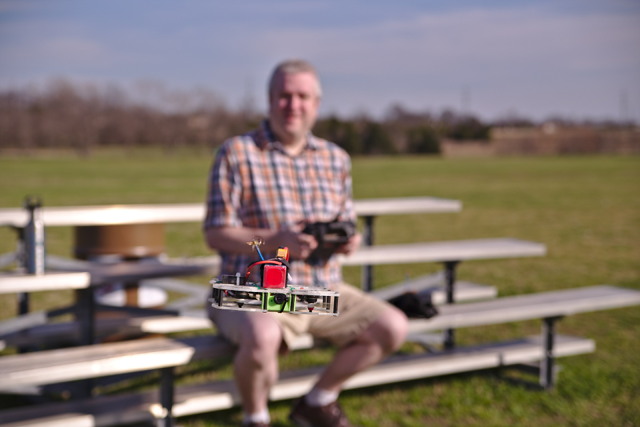
Bumping into the ground is common, and it usually isn’t a problem. He hit the ground, rolled 20’ or 30’ and ended up in a large pond. He was in the goggles, so he had no idea where it rolled in.
We nearly lost a LAB210 on build day
I was at the park, but I didn’t get to see any of this. I think Brian Moses was assisting two of the pilots that were flying line of sight while I was flying a quick battery in my Shuriken X1. I did hear some of it, though!
Brian Beverage was flying his brand new 5” racing quad line of sight for the first time at Oak Point Park. It is a huge park, and we were in a big open field. It is at least 1,200’ long and around 400’ wide.
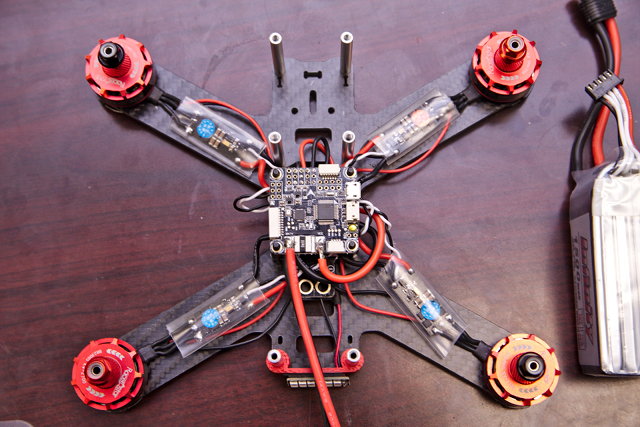
Brian’s new drone was getting a little high up, and it was far enough away that it was just a dot in the sky—the dot of despair! They thought he was over the forested part of the park. It is too dense to walk through, and if he disarmed there, he probably would have gotten stuck in the top of a tree—a tree we couldn’t see!
Somehow, he managed to figure out his orientation and fly back. He was lucky. Brian Moses didn’t think we’d ever see that drone again.
- Learning to Fly A Quadcopter LOS and almost Losing it! at brianbeverage.net
The first missing LAB210 quad
I feel terrible about this one, and I need to accept some of the blame for this one. We had a drone flying meetup at a big, wide-open field about a week after the class where we built the 210mm racing drones. Brian Moses and I went out a bit early to set up some gates and fly a few packs—we figured we’d be instructing more than flying once everyone showed up.
But no one showed up. We flew until about an hour after the event was scheduled to start, then we started packing up. It was up near 90 degrees, I was out of water and batteries, and Brian and I were the only ones flying drones. It seemed like it was time to head out.
On the way out of the parking lot, I passed one of the new pilots from the class. I explained the situation. He said they were going to fly on their own. I figured they’d be fine.
They ended up flying in FPV for the first time. They flew quite high and rather far away. In their attempt to get back, they ended up over on the other side of the thick wall of trees and brush when they ran out of battery and their drone. There is a field over there, but it isn’t maintained. It is all tall, dense grass. You can’t see anything in there.
Tips for new FPV pilots
You’re a new FPV pilot. You want to be safe, and you don’t want to lose your drone. Here’s a list of tips for you.
There’s nothing new here. Brian and I say all of these things quite often, but there’s no guarantee that we’ve managed to say these things to every student. Compiling a list seemed like a good idea!
When in doubt, disarm
If you’re having any trouble, and you don’t know what to do, you should hit your disarm switch. Falling out of the sky is often your best option.
You don’t want your quad to get so far away that you’ll never find it. You don’t want your quad to crash into expensive property or people. It is much better to just fall out of the sky. You might break a prop. You might break a motor. Hopefully you won’t lose the whole drone!
At the angle I hit that tree, I was worried that I’d fly out directly towards the area where we were all sitting. I was moving my hand to flip the switch before I ever could have seen that.
Get some line of sight under your belt
I spent a month or two flying line of sight before I ever put on a pair of goggles. I flew the tiny Blade Nano QX around the house for a month, and then I flew my PH145 line of sight outside for two or three weeks.
You don’t have to become a line-of-sight master—I’ve gotten much worse at it! It is a good way to get a feel for the controls, and a great way to get a hang of controlling your throttle.
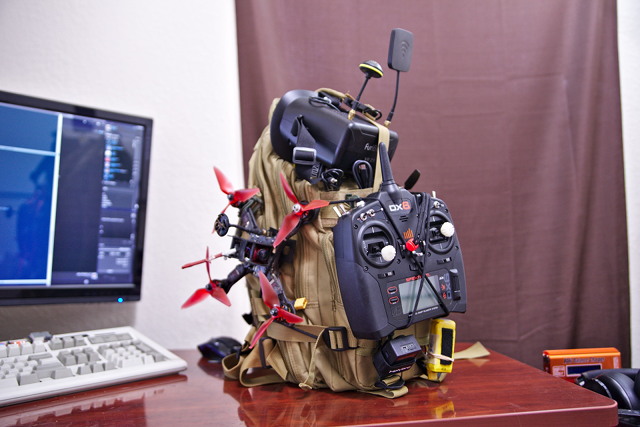
A lot of people are putting time into the simulators. Supposedly, that lets you skip the hours of learning line of sight, and you can skip directly to the first-person view.
I am certain that practicing in the simulator is a faster path to FPV proficiency, but observations tell me that you shouldn’t skip your line of sight practice completely.
Stay away from people, roads, and cars
Don’t hurt anyone. Don’t damage anyone’s property. Don’t scare people that are driving.
Be safe. Don’t ruin the hobby for everyone else. If you take out someone’s windshield, you’ll make things harder for the rest of us!
Always have a buddy
Always. Always have a buddy. When you’re in the goggles, you have a different perspective on the world. One tree often looks just like another. Your buddy should be watching your drone. He should tell you when you’re getting too far away or doing something dangerous. He should also be watching for unexpected pedestrians!

He’ll also be able to tell you where you crashed or disarmed. If he can’t, you’re flying too far away!
Altitude is your friend
If things get sketchy, it is almost always a good idea to gain altitude. It will give you time to recover. If there’s a more experienced pilot present, it may give you time to hand over the controls.
Too much altitude is scary
Altitude may be your friend, but too much altitude is scary. The FAA says you have to keep it under 400 feet. I prefer not to fly much more than twice as high as the trees—it is boring up there, and the higher up you are, the more difficult it is to safely get back to the ground.
In this video, you can see that I’m flying up above the trees, but as I’m coming back towards the ground there are trees on just about every side of my drone. I’ve been flying in FPV for eight months, and this still makes me nervous. If you went back six months, I probably couldn’t do this without hitting something.
Losing altitude is easy. Losing altitude and ending up where you want can be much more difficult!
Don’t fly FPV in angle or horizon mode
It is safest to keep moving forward when you’re flying in FPV. Angle and horizon modes work well if you want to hover in one place, but that’s how you bang into things in FPV. You might think you’re standing pretty still, but the breeze might be moving you backwards or sideways. You can only see in front of you.
Air mode or rate mode is a bit like driving with cruise control. You can tip your drone slightly forward, let go of the sticks, and the drone will maintain that angle of tilt. At that point it is just a matter of maintaining altitude with the throttle and steering with yaw.
Lots of new pilots argue with me about this. I even tried to fly FPV in horizon mode when I first started. It was a terrible idea then, and it is a terrible idea now.
Start small and work your way up
I spent dozens of hours learning to fly line of sight before I ever strapped a set of goggles on. Even then, flying FPV was difficult. I was extremely proud of myself when I managed to put the goggles on, take off, fly a slow lap around a big field, and make a rough landing 20 feet from where I was sitting.
You’re going to have enough failures doing the easy stuff, so don’t try the hard stuff first.
Push your skills
I know I said to start with the easy stuff, but that doesn’t mean you shouldn’t push yourself. I burned through more than a few batteries just learning how to circle the park at about 30’ or 40’. I was moving a little faster each time, and I was doing a better job of coming in for a landing.
I started working some rolls into my laps around the park. It took me quite a while to get comfortable with those, but I kept practicing.
My friend Alex encouraged me to learn to fly near the ground. For a long time, that meant flying six to ten feet from the ground. Then Alex made me go fly in a field full of trees. I didn’t think I could do it, but I managed. I crashed a lot, but I managed!
Some of our group took a different path. While I was learning to fly in proximity of trees and the ground, they were learning to do tricks up in the sky: loops, rolls, and split-Ses. I was more than a few months behind on learning to do a split-S!
Watch your batteries
Most of us are running 1,300 or 1,500 mAh 4S LiPo batteries on our 5” quads. If you drain them all the way, you’ll significantly shorten the life of your batteries.
I used to watch the mAh readout in my goggles, and I would start to fly home to land at around the 1,000 mAh mark. That was back when I used to fly rather slow, and it was a good plan at the time.
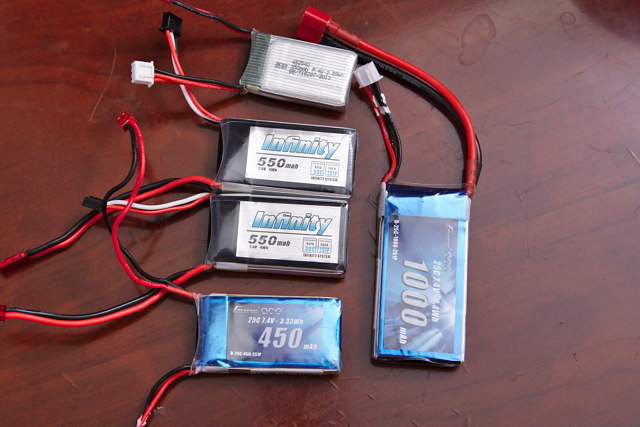
These days, I only watch my voltage. When you’re hard on the throttle, you’ll see your voltage sag into the low 13 volt range. I don’t pay much attention to that. I watch my voltage when I’m cruising and maintaining just enough throttle to stay airborne.
When my cruising voltage drops to 14.5 to 14.7 volts, I know it is time to land. It won’t hurt if I go a little deeper, but by that time, you’ll notice your punch outs getting weaker.
VTX etiquette is important!
There is a limited amount of bandwidth available for our FPV video signals. If you power up your drone while I’m in the air, you run the risk of knocking out my video signal!
If you’re on the same channel as your friend, you will stomp all over their signal, and they will almost definitely crash. Even if you’re not on the same channel, your VTX may generate noise on their frequency as it is powering up. This is very common, and it will probably cause a brief drop out in your friend’s goggles.
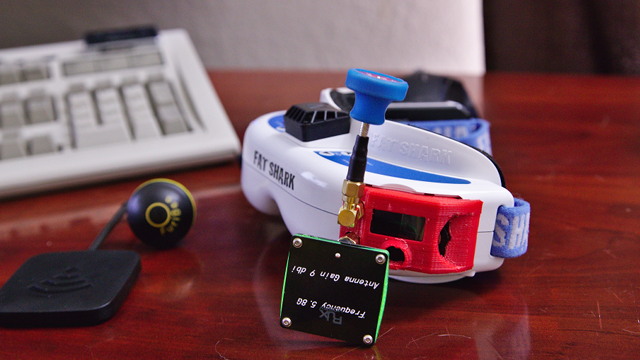
My friends and I mostly do freestyle flying at parks. We’ve found that it is best to walk ten or twenty feet away from where the pilots are sitting before powering up your drone—the farther the better! It is especially important to not fire up your quad directly in front of another pilot’s directional antenna.
You’ll usually hear us saying things like, “Can I plug in?” or “Are you safe? Can I plug in?”
You don’t want to plug in while someone is about to hit a gap, or when they’re on course to get stuck in a tree!
We’ve been getting better at practicing our etiquette, and most of us have upgraded our equipment. When we were using cheap Eachine or Furibee goggles, we’d almost always see a tiny blip when our friend plugged in their drones—even if they were 20 feet away! I never see a blip in my Fat Sharks with my RX5808 diversity module.
Don’t be the last to show up and the first to leave
Setting up a track and putting up race gates is a lot of work. Taking them down and packing them up isn’t much fun, either!
Don’t be the guy that shows up after everything is set up and then leaves before its time to clean up. If you’re having fun flying the track, you should help tear it down.
People are understanding, and they won’t be upset if you only do this once in a while. Don’t make it a habit—people will notice!
Conclusion
Practice safe flying. Some of this may seem like common sense, but when you’re new at this, you might not realize how difficult flying a quadcopter in FPV can be!
Don’t put people or property in danger. Don’t scare anyone. Don’t be afraid to push yourself past your limits, but don’t push too far too fast. Find your limits first, then push past them a little at a time.

Learning takes time, but everyone I know seems to be making constant progress. They’re also enjoying themselves at every step on their journey. I had fun when I was flying line of sight. I had fun when I was lucky to circle around a big, empty field in FPV. I had fun when I could barely fly through a drone gate. I’m currently having just as much fun practicing s-turns and power loops over trees!
Don’t let it bother you if your friends are better pilots. They’ve probably have a lot more stick time than you, and you can get there with practice. They were at your skill level once, too, and they were still having a ton of fun flying!
Did I miss any important tips? Please leave a comment and let me know what I left out!